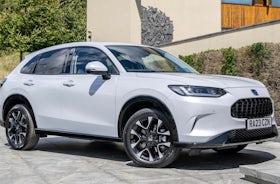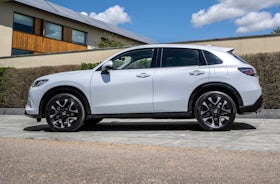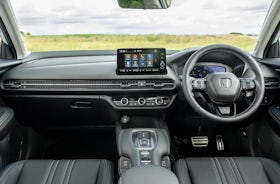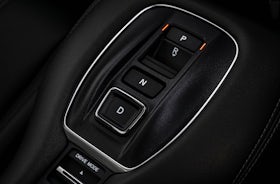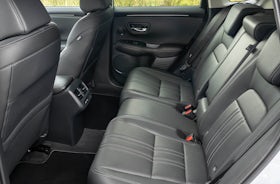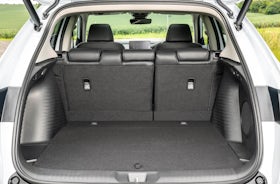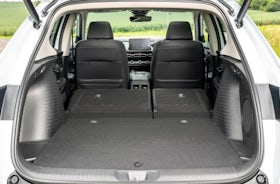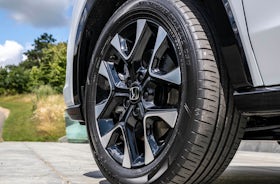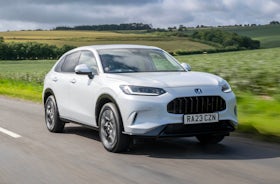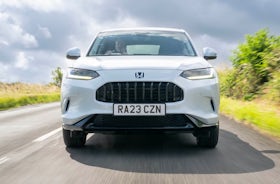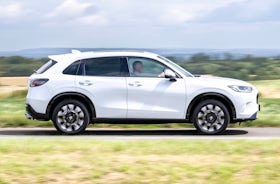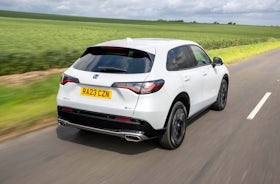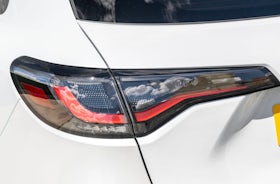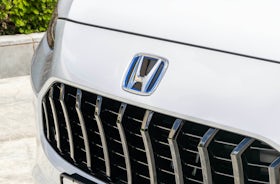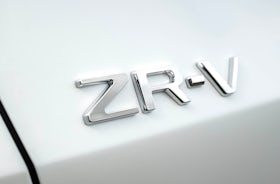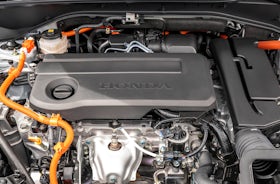Honda ZR-V Review & Prices
The Honda ZR-V is a mid-size SUV that's nice to drive, but it’s a shame it’s not spacious as alternatives
- Cash
- £33,266
- Monthly
- £408*
- Used
- £22,371
What's good
What's not so good
Find out more about the Honda ZR-V
Is the Honda ZR-V a good car?
The Honda ZR-V is a mid-sized SUV, which sits between the larger CR-V and the compact HR-V in Honda’s SUV line-up. It’s good to drive with a great hybrid engine, but it’s not massively practical and some aspects of the interior feel distinctly old-fashioned.
As Honda’s CR-V grew bigger from generation to generation, a gap opened up underneath it which has been filled by the ZR-V. It’s an alternative to compact-yet-popular SUVs such as the Nissan Qashqai, Hyundai Kona and Toyota C-HR. Underneath, it’s based on the same mechanicals as the brilliant Civic, so it’s off to a good start.
But the ZR-V seems to lack a bit of purpose - it’s filling a gap that didn’t really exist, as the smaller HR-V is arguably even more practical and the CR-V fits the brief if you wanted a larger car. It’s a bit like the iPhone Air - it’s not a bad product, but was there really space between the iPhone 17 and the 17 Pro that needed filling?
Stylistically the ZR-V is a bit of an odd duck, as it doesn’t really match anything in Honda’s current range. It’s curvaceous, with a sloping roofline at the rear and a low-set grille at the front - different to the upright and rugged-looking silhouettes of the HR-V and CR-V.
That’s less the case inside, where the infotainment screen, switchgear and materials are all pure Honda - but even here it’s a little different with a swoopy centre console that impacts practicality without really adding too much.
Speaking of practicality, space in the back is good - even despite the swoopy roofline, adults will be able to get comfortable, and the slightly staggered seating arrangement ensures that even kids in the back get a good view out.
The small battery pack gets its charge from the petrol engine, yet the driving experience is more like a pure EV as the electric motors power the wheels
The payoff is the boot, which at just 380 litres in capacity is really puny for a family car. Even the regular Civic hatchback has more space, and it’s eclipsed by just about every other family SUV - plus, unlike the smaller HR-V, the rear seats don’t have any clever tricks to help maximise the load area.
The ZR-V uses the same dashboard design as all of Honda’s cars, which has some plus and minus points. It’s beautifully built out of solid, dense-feeling materials, and the glut of physical buttons is a fantastic thing to have when so many cars are going touchscreen-only.
But the ZR-V’s infotainment display feels sluggish and the menu system is appalling - poorly laid out and confusing. Tech levels on this car aren’t up to the standards set by things like the Renault Symbioz with its fantastic Google–powered setup.
To drive, it’s again a bit of a mixed bag. The ZR-V uses the same 2.0-litre self-charging hybrid engine as the Civic, which is really smooth, refined, and more than powerful enough. It also feels a bit sportier than the alternatives thanks to direct steering and a firmer suspension setup than most - but the payoff is that it’s not as comfy as it could be.
In addition, the hybrid can feel a little gutless compared to the Nissan Qashqai e-Power - and there’s no plug-in hybrid option like you get with the Toyota C-HR, Kia Sportage or Jaecoo 7 to save you on your company car bills.
If you want to get the best deals on the Honda ZR-V or other new Hondas, check out Carwow, where we can also offer you great used Honda deals. You can even sell your car with the help of our trusted dealers.
How much does the Honda ZR-V cost?
The Honda ZR-V has a RRP range of £35,995 to £40,295. However, with Carwow you can save on average £2,834. Prices start at £33,266 if paying cash. Monthly payments start at £408. The price of a used Honda ZR-V on Carwow starts at £22,371.
Our most popular versions of the Honda ZR-V are:
| Model version | Carwow price from | |
|---|---|---|
| 2.0 eHEV Elegance 5dr CVT | £33,266 | Compare offers |
Some of Honda’s cars seem pretty overpriced, but the ZR-V bucks that trend - if you want a Honda SUV particularly, it makes the CR-V look very expensive indeed. With a starting price of around £34,000 it’s in line with the Nissan Qashqai e-Power, though it’s a little more expensive than cars it aligns with on practicality - such as the Toyota C-HR or Hyundai Kona Hybrid.
The entry-level Elegance trim comes with all-round parking sensors, a reversing camera, 18-inch alloys, keyless entry and start, a digital driver’s display, adaptive cruise control, and built-in nav - quite an extensive list. If you step up to the Advance model you get leather upholstery, a premium stereo, panoramic glass roof, powered tailgate, privacy glass and adaptive headlights.
Performance and Drive Comfort
While the ZR-V is quiet and composed in town, you will hear a lot of tyre roar and wind flutter on the motorway
In town
With its super quiet electric motor, the ZR-V glides through town without too many issues. As an EV-driven car, you get decent acceleration from the motor to help you away from junctions, and the petrol engine only kicks in if you really want to push hard.
You have a large rear window, two ample wing mirrors and relatively slim A-pillars to ensure you have good visibility. That’s aided by a rear-facing camera as standard, while front and rear parking sensors help with manoeuvring.
What you will notice is that sharper bumps will be more pronounced in the cabin if you’re driving at slower speeds, but they’re smoothed out well the faster you go.
On the motorway
Even with plenty of sound insulation to offer a quieter cabin, the ZR-V suffers from a lot of tyre roar, and wind flutter from the wing mirrors, at motorway speeds. All cars come with 18-inch alloys – of varying design – so getting a smaller set of wheels isn’t possible to help with that.
Turn the radio up though, and while you’ll still notice that exterior disturbance, the ZR-V is very comfortable to travel in. The seats are well-bolstered – barring some lumbar support – and you can get in position to have a good view around.
Getting up to speed with the electric motor driving the front wheels is no trouble, and although it’s not lightning quick, it’s more than fast enough. Overtakes are simple, and with blind spot monitoring and adaptive cruise control as standard, cruising is very simple.
On a twisty road
The ZR-V is by no means a performance SUV, but it handles itself well. It feels better to drive quickly than most of its alternatives, as the steering is light at first but has more weight as you turn the wheel tighter.
You won’t feel too much body roll unless it’s a particularly sharp turn, so you can take corners at the speed limit without much hassle. You also shouldn’t expect much disruption through the suspension, unless there’s a particularly rough surface, at which point the ZR-V starts to feel less planted.
You can engage Sport mode – as well as Comfort, Eco and Snow settings – but doing so doesn’t change the driving experience much. There’s a touch more throttle response and the steering has a little extra weight, but it’s not necessary unless you really want to.
Space and practicality
The cabin is spacious enough for most with plenty of storage, but the ZR-V struggles a bit in terms of practicality
Up front in the ZR-V, you’ll find ample room for the driver and passenger, as well as good levels of adjustment in the seats. Sport and Advance models get electric seat adjustment to make the process even easier.
The door bins are of a decent size, but while there’s a good space for a water bottle, the rest of it is a bit thin. You’ll also find a couple of charge ports and a place for your devices under the central armrest, while two cupholder sit in front of another storage bin. The cupholders are quite large though, so smaller cups and bottles can topple over.
Under the armrest, which annoyingly can’t be adjusted, there’s a deep space to keep things too.
Space in the back seats
People sitting in the back seats will have enough space to be comfortable. There’s good knee room, while head room is also rather good. That can be hampered by the sunroof on Advance models though, and under thigh support isn’t the best.
The doorbins are only big enough for one bottle each, while you have rather large pockets on the seat backs. There’s two USB-C charging ports for your devices, and folding the middle armrest down reveals two cupholders.
There’s two sets of ISOFIX points as well that are easy to get to, and though the door opening isn’t the widest, it’s more than roomy enough for you to get a bulky rear facing child seat in place.
Boot space
This is where the ZR-V falls behind its alternatives. You’ll only have access to 380 litres in the boot, and that’s reduced further if you choose the Advance model, as the Bose 12-speaker sound system’s subwoofer takes up 10 litres.
The NIssan Qashqai, which has a similar hybrid system with its e-Power version, offers 435 litres, while the self-charging hybrid Kia Sportage and Hyundai Tucson models offer 587 litres and 616 litres respectively.
You don’t get through loading with the ZR-V either, but you get split-folding to help with loading longer items. There’s a handy space to put the load cover under the floor though, as well as a load lip level with the floor so you can slide things in and out easily enough.
Folding down the seats opens up a 1,312-litre space. There’s no ridge to push things over, so you can load larger items easily. You’ll also see hooks either side to hang bags and a 12V socket.
Interior style, infotainment and accessories
The interior styling of the ZR-V is excellent and it’s very simple to use. It lacks a spark of colour though, with lots of black and grey surfaces
With the ZR-V drawing a lot of inspiration from the similarly-sized Civic hatchback, the interior design of the SUV is excellent. It’s got simple lines with metallic detailing and a bar that crosses the entire cabin housing the air conditioning vents – with easy-to-use toggles to direct the airflow.
The quality of the materials used are rather good, with a lot of synthetic leather on top of the dashboard and around the button-press gear selector. There’s some piano black plastic that can get scratched and smudged, but there’s not a lot of it.
You get climate control buttons and dials separate from the 9.0-inch infotainment screen, which are super easy to use. The same can't be said of the infotainment screen, though - it's awkward to use, slow to respond and feels very outdated compared to the latest and greatest systems.
You can connect your smartphone through Apple CarPlay and Android Auto, but only the Apple system can be connected wirelessly.
There are touches of colour on the touchscreen’s graphics, but there's a lot of grey and black on the display. That theme continues through the rest of the cabin, with cloth upholstery as standard on the seats, while the leather offered on the top-spec Advance car gets some silver stitching.
Behind the standard-fit leather steering wheel is a 10.2-inch digital display. The screen has a dark background, so the coloured graphics do pop and it’s easy to read, but it's not as customisable as you'll find on alternatives. Top-spec cars also get a head-up display, which is simple to read too.
Honda doesn’t offer the ZR-V with many options at all, with different wheel designs and colours the main decision you’ll need to make. There are styling pack options to make it look either rugged or sporty too.
MPG, emissions and tax
You only get one engine choice with the ZR-V – a 2.0-litre petrol engine paired to an electric motor. It develops 184hp and 314Nm of torque, allowing for a 0-60mph time of 7.8 seconds.
With that self-charging hybrid setup, the ZR-V will do 49.6mpg. But through our tests, we found you can easily get above 50mpg if you drive it carefully enough. That means with a full tank, you can do more than 620 miles.
Emissions are kept at a reasonable level of 144g/km CO2, meaning you won’t be paying too high a level of VED. But plug-in hybrid alternatives make much better company car options.
Safety and security
When tested by Euro NCAP, the ZR-V scored four stars, with sub-80% in adult occupant protection and just 68% in the safety assist category letting it down.
The latter may change if it were re-tested, as Honda has since fitted an even more comprehensive suite of safety aids - all the ones you'd expect. Annoyingly, some of these are very irritating in practice, particularly the speed limit warning - and you can't turn it off unless you're stationary. It's buried deep in a totally non-obvious menu, too - this is the kind of feature that leads to swearing.
Reliability and problems
As standard, all ZR-V models come with a three-year/90,000-mile warranty, while you can pay Honda for an additional guarantee when that initial period comes to an end – up to three years extra cover, that also includes road-side assistance.
As the ZR-V is an all-new model, you don’t have any previous recalls or issues to judge it by. If the current Civic is anything to go by though – which uses the same powertrain and is a similar size – you shouldn’t have concerns as its reliability record is excellent so far.
Honda ZR-V FAQs
- Cash
- £33,266
- Monthly
- £408*
- Used
- £22,371
Configure your own ZR-V on Carwow
Save on average £2,834 off RRP
Popular Honda ZR-V transmissions
Popular Honda ZR-V colours
*Please contact the dealer for a personalised quote, including terms and conditions. Quote is subject to dealer requirements, including status and availability. Illustrations are based on personal contract hire, 9 month upfront fee, 48 month term and 8000 miles annually, VAT included.


